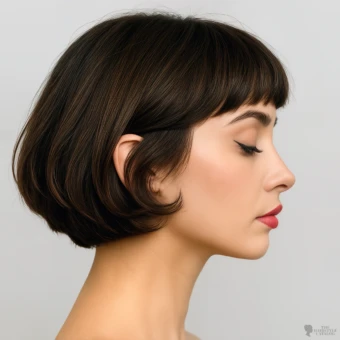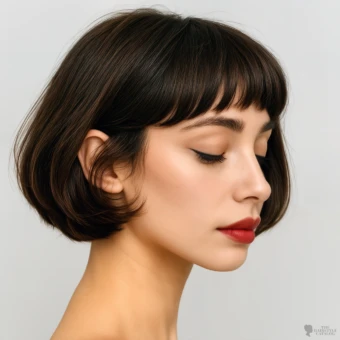French Bob with Micro Bangs – Chic Short Parisian Style
Summary
The French Bob with Micro Bangs is a short, jaw-skimming bob cut with a softly rounded silhouette and a petite, straight fringe. It blends precision and ease: sculpted enough to frame the lips and cheekbones, yet lightly tousled for that effortless Parisian finish. Elegant, romantic, and a touch mischievous, it flatters many face shapes and transitions seamlessly from daytime chic to evening polish.
The French Bob with Micro Bangs
This hairstyle is short in overall length, typically ending between the mid-ear and the jawline. The perimeter line is clean with a gentle bevel that curves inward, creating a compact, bowl-kissed shape without looking severe. Subtle internal graduation at the nape keeps the cut tucked in and prevents a boxy back view. The front is the star: weight is kept through the mid-lengths so the hair cups the cheekbones, draws the eye to the lips, and softens the jaw.
The fringe is cut as micro bangs (sometimes called baby bangs): a narrow, straight fringe that sits above the brows by a few millimeters to a centimeter. On many versions the edge is slightly rounded to echo the bob’s curve, with the corners feathered so the fringe blends into the temple area rather than stopping abruptly. The crown has minimal layering—just enough to prevent a helmet effect and to encourage a natural, airy lift.
Texture is key. The French bob is rarely pressed pin-straight; instead, it’s styled with a soft, touchable finish—think smooth with a whisper of movement. Natural wave is embraced and enhanced with a light blow-dry using a round brush or a flat brush with beveling at the ends. On straighter hair, a quick bend with a large-barrel iron can mimic that soft under-curve. The finish should look “done, then lived-in”: a satin sheen rather than high gloss, with a tiny bit of dry texture at the perimeter so the ends don’t collapse.
Parting is flexible. Many wear it without a strong part because the fringe disguises the root direction, but a micro off-center fall looks authentically French and keeps the crown from splitting. The hairline around the ears is usually kept neat; some stylists lightly taper the sideburn area to prevent puffiness and to ensure earrings and cheekbones remain visible.
Color works best when it supports the cut’s sculptural lines. Solid shades—chocolate brown, espresso, raven, rich chestnut, deep auburn—showcase the contour, while extremely high-contrast highlights can fragment the shape. If dimension is desired, keep it soft and close to the base: whisper-thin lowlights or a subtle glaze that deepens the bevel.
Face shapes and proportions:
-
Heart and oval faces are natural matches; the jaw-length curve balances a wider forehead and focuses attention on the eyes and mouth.
-
Diamond faces benefit from the micro fringe, which shortens visual forehead height and softens angularity.
-
Round faces can wear it by keeping the perimeter a touch longer at the front and avoiding excess volume at cheek level.
-
Long faces look best when the fringe remains short and straight, and the crown isn’t over-lifted.
Occasion and styling range: It reads polished with lipstick and liner, poetic with bare skin and a sweater, and editorial with a stronger, graphic finish. Because the cut is structured, it grows out gracefully—often into a soft, chin-length bob—making it practical for those who like a defined look without daily fuss.
French Bob with Micro Bangs Hairstyle Overview
| Hairstyle Properties | |
|---|---|
| Alternative Names | French Bob, Parisian Bob |
| Hairstyle Category/Subcategory | Bob / Graduated |
| Complexity | Advanced |
| Hairstyle Volume | Moderate Volume |
| Symmetry & Balance | |
| Texture Finish | |
| Parting/Hairline | |
| Bangs/Fringe Type | |
| Face Enhancements | |
| Hair Suitability | |
| Face Shape Suitability | |
| Hair Length Suitability | |
| Hair Structure Suitability | |
| Hair Thickness Suitability | |
| Hair Curl Pattern Suitability | |
| Hair Health Suitability | |
| Color Treatment Suitability | |
| Practicality | |
| Styling Difficulty | Easy |
| Time to Style | 10 to 15 minutes |
| Maintenance | Moderate (Requires Some Styling) |
| Durability | Up to 12 hours |
| Styling Methods | |
| Styling Tools | |
| Styling Accessories | |
| Other Properties | |
| Gender | |
| Age Group | |
| Occasion | |
| Cultural Origins | |
| Era of Popularity | |
| Special Tags | |
Origin, History & Cultural Influence
The bob cut itself emerged in the early 20th century, gaining momentum in Paris before sweeping through Europe and the United States. Many historians credit Paris-based hairdresser Antoine de Paris (Antoni Cierplikowski) with popularizing a radical short cut around 1909, famously styling stage actress Eve Lavallière and helping to detach short hair from purely utilitarian or punitive associations. In the 1920s, the bob became a symbol of modernity and urban chic, worn by cinema icons such as Louise Brooks and Colleen Moore, and by countless “flappers” who embraced streamlined silhouettes and a freer lifestyle.
The specifically French bob—shorter, more curved, and often paired with a petite fringe—distills that Parisian sensibility: precise but nonchalant, sculpted yet airy. It references several strands of French aesthetics:
-
The Left Bank muse: 1950s–60s French cinema and photography celebrated short, insouciant hair—think of the gamine archetype with wide eyes, natural texture, and just-bitten lips. The French bob borrows the attitude: a haircut that appears effortless but is, in fact, meticulously crafted.
-
Haute coiffure meets everyday ease: Post-war French salons refined beveled bobs and internal graduation techniques, teaching stylists to create shape from within so hair falls into place with minimal effort. That internal work is what distinguishes the French bob from simple one-length chops.
-
Contemporary revival: From the late 2010s onward, the French bob resurfaced globally as a fashion favorite thanks to runway styling, social media, and a broader movement toward shorter, sculptural cuts that photograph beautifully. Its staying power lies in how it treads the line between retro and modern—evoking 1920s and 1960s iconography while feeling fresh with today’s softly textured finishes.
Interestingly, some fashion writers trace the bob’s symbolic spirit even further back—to Joan of Arc, who reportedly cut her long hair short “in a man’s fashion” before donning her armor. While her practical 15th-century crop bore little resemblance to the modern bob, the association endures as a cultural metaphor: a woman adopting short hair as a declaration of resolve and independence. The French bob with micro bangs, clean around the jaw and deliberately assertive, can be seen as a refined modern echo of that same fearless simplicity.
Culturally, the French bob carries connotations of literary, gallery-hopping cool and pared-back luxury. It pairs naturally with classic French beauty choices—clean liner, flushed skin, and a red lip—but it also adapts to minimal or dewy makeup. The cut’s brevity and precision read as intentional and confident, while the micro fringe adds a playful, almost cinematic edge.
The French bob with micro bangs offers clear design logic—short perimeter, controlled bevel, and a small fringe that manages forehead proportions—wrapped in a finish that feels lived-in rather than lacquered. It photographs exceptionally well from every angle (front, profile, and rear), complements turtlenecks and collars, and elevates simple outfits. In salons, it’s a reliable transformation cut for clients seeking character without high maintenance: trims every 6–8 weeks keep the outline crisp, and daily styling rarely requires more than a quick blow-dry with a round brush and a touch of lightweight cream or matte wax at the ends.
Born in Parisian modernism, refined by decades of French craftsmanship, and romanticized through cultural icons from Joan of Arc to Louise Brooks, the French bob with micro bangs remains a timeless, personality-rich choice—romantic, intelligent, and effortlessly chic.

Styling Instructions
This hairstyle is a precision cut that balances structure with softness. It’s best created by a professional stylist familiar with bob geometry and internal graduation, though day-to-day styling at home is relatively simple once the shape is in place. Below are two parts: first, a guide for stylists on creating the cut, followed by instructions for clients or enthusiasts on how to style it perfectly at home.
Professional Cutting & Shaping Steps
(For hairstylists)
-
Preparation and Sectioning
Start on clean, towel-dried hair. Create a horseshoe-shaped section from temple to temple, just below the crown. Clip the top away. Establish a central parting through the nape for symmetry. -
Define the Baseline
Begin cutting at the nape using slight graduation (about 10–15° elevation) to encourage a curved, tucked-under shape. Follow the natural head contour and keep tension even. Continue around to both sides, maintaining balance. -
Shape the Perimeter
Move to the sides and connect the length to the back guideline, cutting slightly longer toward the front so the bob curves subtly toward the chin. Avoid harsh angles—the French bob’s strength lies in its rounded flow. -
Internal Graduation
Release the top section. Work through horizontal subsections, elevating each about 45° to remove internal weight. This ensures the hair collapses into a clean bevel when dry, not a flat wedge. -
Create the Micro Bangs
Comb the fringe forward naturally. Cut bluntly just above the brows—typically 0.5 to 1 cm higher—then soften the edges with point-cutting or slide cutting. Slightly curve the fringe line downward toward the temples for seamless blending. -
Detail and Polish
Dry the hair naturally or with a paddle brush to check how the shape falls. Adjust balance by refining the perimeter freehand. Use thinning shears only if absolutely necessary; the texture should come from cutting technique, not thinning.
At-Home Styling Guide
(For everyday wear)
-
Start with Clean, Damp Hair
Apply a lightweight volumizing mousse or smoothing cream, depending on your texture. Avoid heavy oils that can weigh the ends down. -
Rough-Dry for Shape
Using your fingers, lift the roots as you blow-dry, following the natural curve of the head. Focus airflow downward to preserve shine and control frizz. -
Refine with a Round or Flat Brush
For a smooth, softly tucked finish, use a medium round brush or flat brush to bend the ends slightly inward. Dry the fringe forward and downward, directing the air from crown to forehead to keep it sleek. -
Set the Texture
Once dry, enhance movement with a drop of styling cream, texturizing spray, or a light matte pomade rubbed between palms. Tousle gently to break up any stiffness. -
Finishing Touches
Mist lightly with flexible-hold hairspray if needed. The goal is polish with movement—avoid anything that looks too “set” or lacquered.
Professional Tips
-
Use minimal heat; over-straightening removes the natural Parisian softness.
-
Trim every 6–8 weeks to maintain the fringe length and the curve at the jawline.
-
If hair is naturally wavy, diffuse or air-dry with a curl cream for a romantic, undone version.
-
To refresh between washes, a dry shampoo at the roots restores lift and separation.
The French Bob with Micro Bangs should look like it “fell into place.” Every step—from cutting to styling—should enhance that illusion of effortless, timeless beauty.







